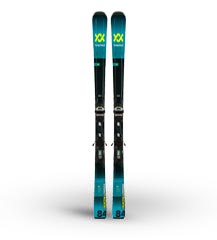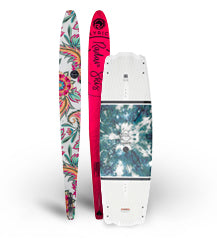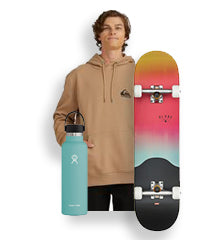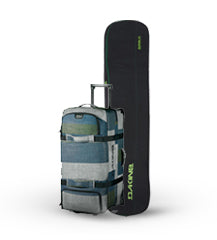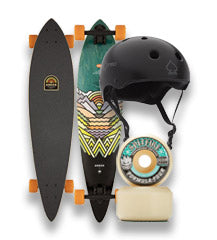How to Choose a Wakeboard & Wakeboard Size Chart - Finding the Right Wakeboard
December 30, 2020 7 min read
Shop Waterskis Now - Fast & Free Shipping Available 🙌
How to Choose a Wakeboard & Size Chart
When it comes to wakeboarding, everyone has to start somewhere! It can be daunting for some to find the perfect wakeboard for their next water adventure, especially if you’re just starting out. If you are doing your research online this is a great place to start or alternatively you can drop in-store to chat with our knowledgeable team, even better!
Whether you’re deciding if a longer or shorter wakeboard is right for you or finding the right style and shape to best manoeuvre through the water, this guide will give you our tried and tested recommendations from our seasoned wake specialists on the right size wakeboard for you.
Wakeboard Size Guide
Picking the Right Size Wakeboard Length For You
There are some amazing locations in Australia to go wakeboarding so there is no better time than to get out on the water, but first, finding the right size board. A great starting point for finding the perfect wakeboard that will provide good times all summer long is to understand the size of the board. If you are looking at a short or long wakeboard, you need to consider your weight and riding style. Every wakeboard model has specific sizing recommendations or requirements provided from the manufacturer. If you’ve tried someone else’s board or you’re finding some discomfort with your wakeboard it may not the best fit. We advise people who are wanting a comfortable and enjoyable wakeboard ride to follow this size chart below which suggests the recommended wakeboard sizes, dependent upon different weight classifications. If you're more into skiing you can check out our waterski size guide here.
What Size Wakeboard Do I Need?
| Rider’s Weight (kg) | Wakeboard Length (cm) |
|
< 50kg |
< 130 |
|
50kg to 70kg |
130 to 134 |
|
60kg to 80kg |
135 to 139 |
|
75kg to 110kg |
140 to 144 |
|
90kg to 125kg |
> 144 |
Note that the same goes for height, where the typical rule of thumb is that the taller you are the more likely it is that you will need a longer wakeboard. This chart above is a rough guide, and it’s always best to come in-store and check them out where our experienced team can help you out.
Is a Longer Wakeboard Better?
If you are looking for an easier transition into wakeboarding or you are a beginner looking to start wakeboarding, we recommend a longer wakeboard. This is largely due to the weight of the boards which allows for better control both in air and on the water as well as a great starting ground to learn the ropes of wakeboarding and how to complete tricks for the first time. In general, longer wakeboards offer a larger surface area to work off which makes manoeuvring through the water much easier and quicker as well. Because of the larger surface, you will have softer landings and be able to float far more easily than having a shorter board. Keep in mind because of the larger surface area, you will encounter a slower response when you go from toe side to heel side of the wakeboard. Additionally, because of the heavier weight of the board, it may be harder to perform more advanced tricks once you have got the hang of it.
Is a Shorter Wakeboard Good?
A shorter wakeboard makes for a completely different wakeboard experience compared to a long wakeboard. Generally, with more experience gained you will change to use a shorter wakeboard. A wakeboard that is shorter in length, will have faster response times when it comes to changes in the toe and heel side. You will also notice that completing complex tricks are done with ease on a shorter wakeboard. It is significantly easier to move and spin in the air as you flip or fly across the water on a shorter board. The common limitations which you might encounter are that it requires more energy and skill (to some degree) to push through the water since it is lighter than longer wakeboards. Landings are not as soft as longer wakeboards which means you need to have strong knees for landing or you’ll wipe out.
Wakeboards for Beginners to Advanced; Boards Designed For Everyone
Do not be discouraged if you have never got on a wakeboard. Generally speaking, wakeboards come in many different shapes and sizes that are designed for beginners right through to advanced wakeboarders. However, this doesn’t mean that you are limited to a certain type of wakeboard, you are more than happy to try out an expert wakeboard if you are a beginner. The suggestions in this article are designed to give you information on what we have seen to be the most appropriate for each category. We’ll just say it one more time, wakeboards are designed for everyone.
If you're a beginner, you can also check out our top 5 wakeboarding tips for beginners.
Wakeboard Rocker Types
Finding Your Style: Wakeboard Rocker & Riding Style
Continuous Rocker Wakeboards
A continuous rocker is a fluid design shape; a fully curved shape which allows for smoother and swift rides where it offers an easier turning experience. These wakeboards are fantastic for carving throughout the wake where you can generate high speeds especially on flat, glass-like waters. With its curvature design, you would expect a predictably smooth ride.
3 Stage Rocker Wakeboards
A 3-stage rocker is commonly a wakeboard which offers a greater pop (height) once you hit the wake. With this in mind, this is not necessarily the most envious option in all circumstances as you can experience more friction on the water which will alter your speed. These boards are ideal for more aggressive wakeboarding.
Hybrid Rocker Wakeboards
Finally, a hybrid wakeboard is a mashup of both the continuous and the 3-stage rocker. These wakeboards are specifically tailored for riders who are still yearning for a more aggressive pop but still maintaining some speed.
Wakeboard Base Shapes & Materials
Some of the wakeboarding lingo can be confusing for beginners or those doing research in preparation for getting out on the water, so we’ve broken down a few of the terms you’re most likely to come across when choosing a board, and learning about its shape and materials.
Channels
The long, extruded fins on the bottom of the board are termed channels, and it’s these guys that break surface tension before the rest of the wakeboard hits. Think swan dive vs. bellyflop.
Concaves
Concaves are what creates lift, these are the special quarter-circle dents on the bottom of your wakeboard that act as suction-reducing accelerators so the board sits higher in the water allowing you to cruise all day long. It’s important to note, where the concaves are positioned will alter how high the board rides as well.
V-Shape Spines
V-shape spines help to soften landings. The spines allow you to roll from edge to edge easily, similar to the v shaped hull of some boats. Most 3-stage rocker wakeboards have v-shape spines to help soften landings.
Featureless
Featureless wakeboards are those without any molded fins or channels and basically leaves the performance of the board to its shape alone.
Grind Base
The popularity of rail-riding lead to the development of grind bases which requires a tough base with exceptional durability to withstand the wear and tear from sliding over PVC, metal or docks.
Base Material
You will want to consider base material if you plan on using your wakeboard on sliders that may impact the base.
Wakeboard Edges & Fins
Sharpness vs. Variable Edges
Fins are designed to grip the water but can vary by numerous factors such as size and/or placement on the wakeboard. A fin placement that is deeper or longer tends to create a more stable ride and minimise the ability to perform tricks – this is a great option for beginners finding their form. As you get the groove of things, you can start to remove the fins and select a board that reduces traction providing an opportunity to start performing tricks both on the water or in the air.
Fin Placement & Size
Fins are designed to grip the water but can vary by numerous factors such as size and/or placement on the wakeboard. A fin placement that is deeper or longer tends to create a more stable ride and minimise the ability to perform tricks – this is a great option for beginners finding their form. As you get the groove of things, you can start to remove the fins and select a board that reduces traction providing an opportunity to start performing tricks both on the water or in the air.
Removable or Molded-In Fins
There are two types of fins which can be ideal for your wakeboard. A removable fin allows for continuous customisation and can be removed and/or unscrewed if damaged or unwanted. However molded fins are permanent and are glassed into the wakeboard. The benefits of having a molded fin are that they are quite secure and more durable than the removable fins.
Fin Maintenance
It’s always best to routinely check your board and ensure that fin screws are secured. If they do come loose or go missing, just note that these are removable fins which can always be replaced.
How to Take Care of Your Wakeboard
It is strongly recommended to always wash your wakeboards with fresh water after using it in saltwater. Wakeboards will last best when stored in a cool, dry area out of the sun which can damage the board. For added protection, investing in a quality wakeboard bag for storage can make all the difference as well. Just ensure that the wakeboard gear is dry before being stored away.
Shop Everything you Need to Hit the Water
MOST POPULAR
RISING POST
Leave a comment
Comments will be approved before showing up.
Also in Blogs

How to Kneeboard for Beginners: Tips, Tricks, and Safety Advice
August 21, 2025 11 min read

The Ultimate Guide to Snowboarding at Rusutsu Resort, Hokkaido
July 15, 2025 13 min read

10 Wakeboarding Accessories Every Rider Needs in 2026
June 16, 2025 9 min read



